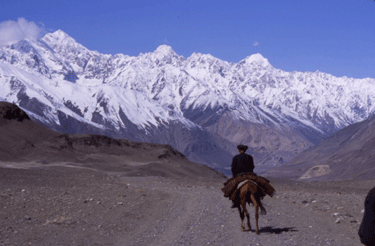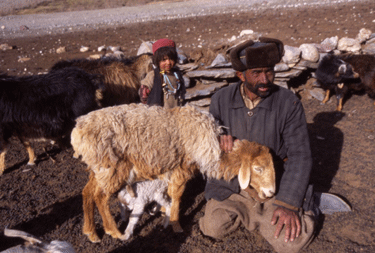Walking the Wakhan
Air Date: Week of November 4, 2005
Mark Jenkins of Outside magazine retraces the steps of Marco Polo and takes to the Afghanistan part of the Silk Road called the Wakhan Corridor. Jenkins tells Living on Earth’s Steve Curwood that this remote land is a wild frontier with an unusual political history.
Transcript
GELLERMAN: It's Living on Earth. I'm Bruce Gellerman.
In the late 13th century, in search of a New World and new merchandise, Marco Polo traveled from Venice, Italy, to China, along the trade route known as the Silk Road. In those days, the main form of land transportation was horseback or foot, and travel took months, sometimes years.
Some 700 or so years later, Mark Jenkins decided to retrace Marco Polo’s steps through a stretch of the Silk Road known as the Wakhan Corridor. The Wakhan is in the northeastern part of Afghanistan, a remote, 200-mile-long strip of land that separates Pakistan and Tajikistan. It’s a region defined by geography, politics, and history, a place that seems to exists in another time.

A Wakhi horseman rides across the Wakhan. (Photo: Mark Jenkins)
Mark Jenkins writes about his trek in the November issue of Outside magazine, and he spoke with Living on Earth’s Steve Curwood about why he wanted to walk the Wakhan.
JENKINS: It was one of those places that always fascinated me in world history. Afghanistan, itself, is a very odd country in some ways because the borders of the Wakhan and much of Afghanistan were created by the British and the Russians just at the turn of the last century, around 1900, to create a buffer zone between two world powers.
And that’s what the Wakhan is, it’s just this strip of land that separates basically the mountainous Tajikistan and all the Pamirs from the mountainous Pakistan and the Hindu Kush. And I knew that the region was extraordinarily remote, and any time you go someplace remote you have the opportunity to kind of step back in time and see the way humans lived a hundred, two hundred, three hundred years ago.

Doug Chabot, Mark Jenkin’s walking partner, on the summit of Koh-e-Bardar. It’s the first ascent in the Wakhan since the 1970s. (Photo: Mark Jenkins)
CURWOOD: What is the physical landscape there in the Wakhan? What’s it like? Can you describe it for me, please?
JENKINS: Sure. I guess you’d just have to imagine a landscape somewhat like Nevada. There’s a valley floor; it’s very dry. There are no trees. There’s a river, the famous Oxis River, that once in Greek mythology separated the known world from the unknown world, passes right down the middle of the Wakhan Corridor. On both sides you’ve got these mountains that rise ten to fifteen thousand feet, right off both sides. So, it’s phenomenal geographic architecture, frankly. It’s just stunning.
CURWOOD: At one point in the story you wrote about this, Mark, you describe the area as medieval. How so?
JENKINS: Medieval in the sense…I mean, it wasn’t meant to be descriptive of some place that’s extraordinarily barbaric, but someplace where the culture is much closer to the ground. In the Wakhan there are no roads. There are no TVs. There’s no electricity. There’s no running water. People live very frugally and it’s a very hard life.
On the western side of the Wakhan, the Wakhis there are traditional farmers, and they’ve got yaks and they pull, you know, a handmade plow, and they pound the barley and they make bread. And in the eastern part of the Wakhan the Kyrgyz, Turkish culture, are sheep herders, and they live in yurts. So, it’s a very simple, a very communal, and a very tough life.

Women in Sarhadd collecting water. (Photo: Mark Jenkins)
CURWOOD: So, you’re on this trek, on foot. Tell me what it would be like when you would stop for the night. Who might take you in? What did they do? How were they making a living?
JENKINS: Making a living is not the right term, probably. There’s not really an economy of any sort; it’s subsistence living. They do trade. They may, for instance…the Kyrgyz, who run sheep, huge herds of sheep, and live in nomadic kind of clusters of yurts. And they have a summer camp and a winter camp, and they’re not unlike the Sioux Indians or something like that following the buffalo herds, although these were domesticated.
What would happen going into a village? We were always taken care of, we were always welcomed as these kind of long lost travelers. They wanted to hear stories. We did have Safraz, our interpreter, with us, so we would sit around the hearth and tell stories about our land and the world we came from, and they would tell us stories about their lives.
CURWOOD: And what would they expect from you in return?
JENKINS: You know, this is always an interesting thing about traveling in remote places. Because you are, you’re a guest in their country, and I think one of the things always expected of you is to share your life. They want to know what it’s like in America. You know, they’ve been to Kabul or something like that. They’ve seen videos. They want to know: do we really fly airplanes? Or does everybody own a car? They want to know about the greater world about them.
Sometimes they need help. I’ll give you a small example that was just really fun. In a small Kyrgyz village near the end of the Wakhan we came to a yurt where the chief had bought a generator, a five horsepower generator. He’d bought it about eight months ago and brought it in on horse, a week on horseback, hoping that his village, just a collection of probably nine yurts, would have lights for the winter.
This is a place that can get between two to ten feet of snow all winter long, extremely cold. Extremely cold. You know, this is at 14,000-15,000 feet, temperatures dropping below 40-below in the winter. No lights. And so he bought this generator, gas-powered, and, sure enough, it worked one day and then it broke. And the village once again – just like they had for the last 500 years? 5,000 years? – had gone through the winter with no lights, other than candles.
So we get there, and the first thing he would like us to do is take a look at this generator. [LAUGHS] Now, luckily, Doug Chabot, my climbing partner, and I had both grown up mowing lawns as kids, right? And it’s the same kind of engine, so we set to work fooling with it, you know, pulling the choke and checking the mixture of the oil and the gas, and we just played with it for about an hour.
CURWOOD: So, what happens the first time you pull the cord?
JENKINS: Nothing. [LAUGHS] And you can just feel the kind of, ‘oh, my god! These guys they come, they should know engines! They live in a world of machines! They should be able to fix this.’ Well, we kept playing with it, and pulling the draw cord, and finally the thing fires to life and the whole village erupts in just enormous pleasure. Just yelling! It was a great moment, it was.
And he’d also brought with him this box of electrical supplies – wires, light bulbs – so immediately we begin stringing the entire village, just like you’d string Christmas lights, with lights. And, of course, they kill the biggest sheep of the herd – a herd of like 800 – they kill the biggest sheep right off the bat, skin it right there, gut it, throw the meat in the pot. And then, about two hours later, we’re served what are considered the delicacies of that culture, and that happens to be the brain and the balls of the sheep. And that’s what we ate.
CURWOOD: Yeah? Which tastes better?
JENKINS: Brains are really soft, and testicles of almost all animals can be a little gristly.
CURWOOD: After your trip into the Wakhan – and, really, a trip back to what Afghanistan was like a hundred or even two hundred years ago – what should folks in the west understand about Afghanistan?

A shepherd and his son in the Wakhan. (Photo: Mark Jenkins)
JENKINS: That it’s a very complex country. It’s got a complicated history. You’ve got foreign forces there, you’ve got fundamentalist forces there, you’ve got an opium trade, you’ve got enormous poverty. And that combination is tough to solve. It takes time, it takes compassion, and it takes a lot of education.
You often hear this from the Afghanis, and you ask them, ‘well, what is their country?’ And they said ‘well, you know, when God made the world he had all these leftover pieces, and he put them all in Afghanistan.’ And it somewhat describes the kind of disparity of the landscape and the complexities of the cultures and the languages. It’s just a huge mishmash of everything.
GELLERMAN: Mark Jenkins speaking with Living on Earth’s Steve Curwood. Jenkin’s article on the Afghanistan Wakhan Corridor is in the November issue of Outside magazine. To see photos of the Wakhan, walk on over to our website, Living on Earth dot org.
Links
“Afghanistan: A Short Walk in the Wakhan Corridor” Outside Nov. 2005 issue
Living on Earth wants to hear from you!
Living on Earth
62 Calef Highway, Suite 212
Lee, NH 03861
Telephone: 617-287-4121
E-mail: comments@loe.org
Newsletter [Click here]
Donate to Living on Earth!
Living on Earth is an independent media program and relies entirely on contributions from listeners and institutions supporting public service. Please donate now to preserve an independent environmental voice.
NewsletterLiving on Earth offers a weekly delivery of the show's rundown to your mailbox. Sign up for our newsletter today!
 Sailors For The Sea: Be the change you want to sea.
Sailors For The Sea: Be the change you want to sea.
 The Grantham Foundation for the Protection of the Environment: Committed to protecting and improving the health of the global environment.
The Grantham Foundation for the Protection of the Environment: Committed to protecting and improving the health of the global environment.
 Contribute to Living on Earth and receive, as our gift to you, an archival print of one of Mark Seth Lender's extraordinary wildlife photographs. Follow the link to see Mark's current collection of photographs.
Contribute to Living on Earth and receive, as our gift to you, an archival print of one of Mark Seth Lender's extraordinary wildlife photographs. Follow the link to see Mark's current collection of photographs.
 Buy a signed copy of Mark Seth Lender's book Smeagull the Seagull & support Living on Earth
Buy a signed copy of Mark Seth Lender's book Smeagull the Seagull & support Living on Earth

